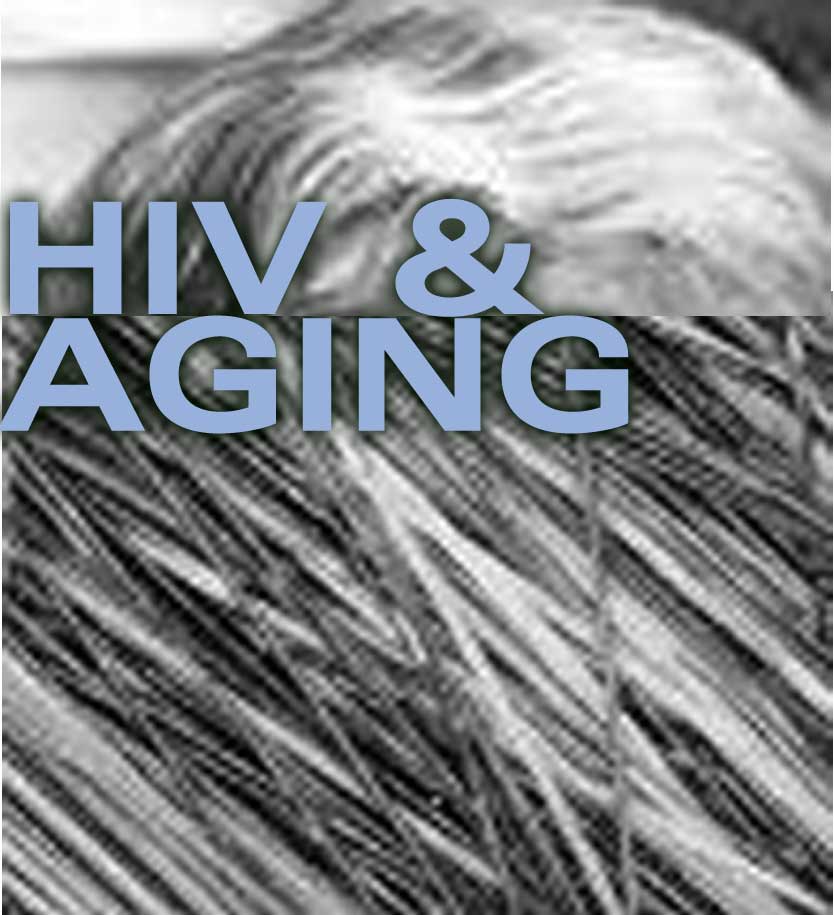
LIVING LONGER WITH HIV
No one 'back then' dreamed we'd be here today discussing these matters. "Then" it was all about ekeing by, just existing and usually attending a memorial service almost weekly.
The perspective has changed -a much better situation. Thanks to all the deities and a handful of stalwart HIV activists who got our medications into the mainstream.Now our responsiblity is to further that effort, to continue writing our history, to honor those we've lost, to make our lives as rich, full and as vibrant as possible and never take a step backward.
Awareness is everything, especially as we wizen (okay, grow older).
BIG FACTORS
Older Americans don't know much about HIV/AIDS compared to younger - how its contracted, spread or prevented. They often don't use condoms and share needles Yes, some seniors are sexually active! Because pregnancy is less of an issue, careless sex seems okay. The percentage of elderly men to women is 1 to 7 ... multiple partners.
Most are in total denial. HIV can be a confusing illness to diagnose in the elderly: hot flashes, night sweats, and depression (often assumed to be part of menopause) can be unrelated to HIV.HAART CAN BE RISKY AT AGE 50+
The immune system may already weakened by age, high blood pressure or heart disease and interactions with HIV medications. Talking to a younger physician is often awkward for seniors. Harsh stigma by younger generation for HIV+ seniors, embarassment, and being at likely risk for dementia (ADC) similar to Alzheimer's disease need to be scrutinized.DIARRHEA may become an issue. Eat fortified, minimally processed cereals and breads for their higher vitamin content and natural plant fiber. Sprouted cereals, breads, pita, wraps, bagels and tortillas may help since the fibers are 'live' and vibrant (contain more authentic life force). To help diarrhea: Eat fewer yeasted bread like products, bakery good .... substitue a lot more sprouted grain products: soy, wheat, barley, any grain, sprouted seeds in salads, all kinds.... Freshness 'personified.'
reference: http://www.fao.org/docrep/005/y4168e/y4168e06.htm
www.FoodForLife.com
A healthy BREAKFAST is even more important for the elderly than everyone else.
CALORIE INTAKE
100 to 2400 calories per day depending ondaily expenditures, needs and physical activitiesENERGY
Varies w/ weight and activity level. The general recommendation is 1800 to 2400 calories per day.PROTEIN
Needs vary based on the person's health status; adequate protein intake would be 1g per pound of body weight.FOLATE needs are heightened. Eat more cereals, deeply colored fruits and vegetables, Vitamin B6 (in whole grains, meat, fish and poultry)
VITAMIN B12
Mal-absorption of B12 is a huge issue; to compensate eat more eggs, chicken, lamb. Due to commonly low acidic condition and bacterial overgrowth, B12 supplementation is vital.VITAMIN C
100 mg/day: oranges, orange juice, tomatoes, watermelon, broccoli, raw cabbageVITAMIN D may be prevalent because of low exposure to sunlight and lessening skin absorption. Under 50 years of age = 10 mg/day; over 50 years of age = 15 mg/day
Cereal with milk helps as will proper multiple-vitamin/mineral supplements; which must be high in calcium (chewables are available)WATER
Lack of adequate hydration contributes to health probelms and cognition. Water is a thermal buffer (steels the body against hypo- and hyperthermia). Drink water BEFORE you feel thirsty.reference: Geriatric Education Center, Peggy Smith, the College of Medicine, University of Florida
You need the guaranteed best water to drink and cook with. Proper hydration with any health condition and medications is absolutely crucial. For the very best water, the author highly recommends Kangen Water™. To learn more about it's surprisingly effective health properties, visit pHantastic Water. Or call or email Steve.
EAT DARK LEAFY GREENS like spinach, orange and yellow vegetables like sweet potatoes and squash, and colorful fruit like strawberries and mangos that are more rich in Vitamins A and C and in folic acid. Cut way back on white potatoes; they're mere fillers. Other nutrient-dense choices are romaine lettuce rather than iceberg, and peaches, apricots, or nectarines rather than apples, celery, or cucumbers.
OTHER FACTORS:
Sense of taste and smell changes, chewing ability, ability to use utensils, difficulty swallowing. The physical environs: hospitalization alone can bring on mal-nourishment and loss of an already low appetite; then there's poor quality hospital food, and depression. Canned meals may help ('Boost,' 'Ensure,' 'Equate'). There are other disease processes and medications to be considered.reference: Robert M. Russell, M.D., associate director of the Jean Mayer USDA Human Nutrition Research Center on Aging (HNRCA) at Tufts

Recent Studies on Cannabinoids and CBDís Effect on HIV & AIDS
Cannabis-like compounds can block the spread of HIV virus throughout the body during infectionís late stages. Cannabinoid Receptor 2-Mediated Attentuation of CXCR4-Tropic HIV Infection in Primary CD4+ T Cells. http://www.ncbi.nlm.nih.gov/pmc/articles/PMC3309010/
Smoking cannabis found to reduced HIV-associated daily pain levels by 34% and chronic pain levels by a median of 72%. Cannabis in painful HIV-associated sensory neuropathy: a randomized placebo-controlled trial. http://www.ncbi.nlm.nih.gov/pubmed/17296917
HIV-positive patients treated with medical Cannabis report significant improvement in appetite, muscle pain, nausea, anxiety, nerve pain, depression and paresthesia. Cannabis use in HIV for pain and other medical symptoms. http://www.ncbi.nlm.nih.gov/pubmed/15857739
Cannabis found to cause substantial increases in food intake in HIV positive patients that suffered from significant muscle loss, without any negative side effects. Dronabinol and Cannabis in HIV(+) Cannabis smokers: acute effects on calorie intake and mood. http://www.ncbi.nlm.nih.gov/pubmed/15778874
Cannabis found to cause increase in daily caloric intake and body weight and an improved rating of sleep in HIV-positive individuals. Dronabinol and Cannabis in HIV-positive Cannabis smokers. Calorie intake, mood, and sleep. http://www.ncbi.nlm.nih.gov/pubmed/17589370
Cannabis found to have no ill-effects on CD4 cell counts in HIV-positive individuals. Short-term effects of cannabinoids in patients with HIV-1 infection: a randomized, placebo-controlled clinical trial. (http://www.ncbi.nlm.nih.gov/pubmed/12965981) HIV-infected individuals consuming medical Cannabis four times per day for five consecutive days reported greater pain relief and improvements in mood and daily functioning. Smoked Medicinal Cannabis for Neuropathic Pain in HIV: A Randomized, Crossover Clinical Trialhttp://www.ncbi.nlm.nih.gov/pmc/articles/PMC3066045/
Copyright © 2005-2019 The Muscle Kitchen. All Rights Reserved.
DISCLAIMER | PRIVACY NOTICE | SHOP | SITE MAP | CONTACT



